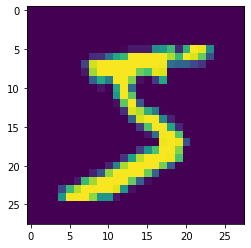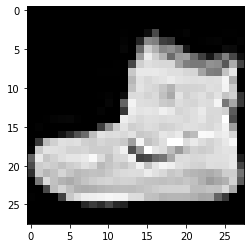Introduction to Autoencoders
This week for my deep learning class we went over autoencoders. An autoencoder is a type of neural network that is used to learn different features of unlabeled data. The network has two main parts: an encoder function and a decoder function that reproduces a reconstruction.
A classical image autoencoder, which is coded below takes an image, maps it to a latent vector space via the encoder function, and then decodes it back to an output with the same dimensions as the original original image, via the decoder function. The network is then trained using the same images as in the input as target data. This means that the autoencoder learns to reconstruct the original inputs. When you impose certain constraints on the output of the encoder, you can get the autoencoder to basically learn interesting latent representations of the data. More commonly though, the enocder is constrained to be low dimensional and sparse– this causes the encoder to act as a way to compress the input data into fewer bits of information.
# import statements
from keras.layers import Dense,Conv2D,MaxPooling2D,UpSampling2D
from keras import Input, Model
from keras.datasets import mnist
from keras.datasets import fashion_mnist
import numpy as np
import matplotlib.pyplot as plt
Normal Autoencoder
encoding_dim = 15
input_img = Input(shape=(784,))
# encoded representation
encoded = Dense(encoding_dim, activation='relu')(input_img)
# decoded representation
decoded = Dense(784, activation='sigmoid')(encoded)
# model takes image as input and outputs decoded image
autoencoder = Model(input_img, decoded)
2022-11-16 12:46:22.257812: I tensorflow/core/platform/cpu_feature_guard.cc:151] This TensorFlow binary is optimized with oneAPI Deep Neural Network Library (oneDNN) to use the following CPU instructions in performance-critical operations: AVX2 FMA
To enable them in other operations, rebuild TensorFlow with the appropriate compiler flags.
# This model shows encoded images
encoder = Model(input_img, encoded)
# create a decoder model
encoded_input = Input(shape=(encoding_dim,))
# last layer of autoencoder model
decoder_layer = autoencoder.layers[-1]
# decoder model
decoder = Model(encoded_input, decoder_layer(encoded_input))
autoencoder.compile(optimizer='adam', loss='binary_crossentropy')
# training and testing data
(x_train, y_train), (x_test, y_test) = mnist.load_data()
x_train = x_train.astype('float32') / 255.
x_test = x_test.astype('float32') / 255.
x_train = x_train.reshape((len(x_train), np.prod(x_train.shape[1:])))
x_test = x_test.reshape((len(x_test), np.prod(x_test.shape[1:])))
print(x_train.shape)
print(x_test.shape)
(60000, 784)
(10000, 784)
plt.imshow(x_train[0].reshape(28,28))
<matplotlib.image.AxesImage at 0x12520b370>

# fit the model
autoencoder.fit(x_train, x_train,
epochs=15,
batch_size=256,
validation_data=(x_test, x_test))
Epoch 1/15
235/235 [==============================] - 2s 6ms/step - loss: 0.3108 - val_loss: 0.2187
Epoch 2/15
235/235 [==============================] - 2s 7ms/step - loss: 0.1966 - val_loss: 0.1805
Epoch 3/15
235/235 [==============================] - 2s 7ms/step - loss: 0.1725 - val_loss: 0.1641
Epoch 4/15
235/235 [==============================] - 2s 7ms/step - loss: 0.1597 - val_loss: 0.1538
Epoch 5/15
235/235 [==============================] - 1s 6ms/step - loss: 0.1514 - val_loss: 0.1472
Epoch 6/15
235/235 [==============================] - 1s 6ms/step - loss: 0.1465 - val_loss: 0.1436
Epoch 7/15
235/235 [==============================] - 2s 7ms/step - loss: 0.1436 - val_loss: 0.1412
Epoch 8/15
235/235 [==============================] - 2s 7ms/step - loss: 0.1415 - val_loss: 0.1394
Epoch 9/15
235/235 [==============================] - 1s 6ms/step - loss: 0.1398 - val_loss: 0.1379
Epoch 10/15
235/235 [==============================] - 2s 8ms/step - loss: 0.1383 - val_loss: 0.1364
Epoch 11/15
235/235 [==============================] - 2s 9ms/step - loss: 0.1371 - val_loss: 0.1353
Epoch 12/15
235/235 [==============================] - 2s 6ms/step - loss: 0.1362 - val_loss: 0.1344
Epoch 13/15
235/235 [==============================] - 2s 7ms/step - loss: 0.1354 - val_loss: 0.1337
Epoch 14/15
235/235 [==============================] - 2s 8ms/step - loss: 0.1348 - val_loss: 0.1332
Epoch 15/15
235/235 [==============================] - 2s 7ms/step - loss: 0.1343 - val_loss: 0.1327
<keras.callbacks.History at 0x1252e6d60>
Normal Autoencoder Results
encoded_img = encoder.predict(x_test)
decoded_img = decoder.predict(encoded_img)
plt.figure(figsize=(20, 4))
for i in range(10):
# Display original
ax = plt.subplot(2, 10, i + 1)
plt.imshow(x_test[i].reshape(28, 28))
plt.gray()
ax.get_xaxis().set_visible(False)
ax.get_yaxis().set_visible(False)
# Display reconstruction
ax = plt.subplot(2, 10, i + 1 + 10)
plt.imshow(decoded_img[i].reshape(28, 28))
plt.gray()
ax.get_xaxis().set_visible(False)
ax.get_yaxis().set_visible(False)
plt.show()

from keras.models import Sequential
Deep Autoencoder
model = Sequential()
# create CNN
# create the encoder network
model.add(Conv2D(30, 3, activation= 'relu', padding='same', input_shape = (28,28,1)))
model.add(MaxPooling2D(2, padding= 'same'))
model.add(Conv2D(15, 3, activation= 'relu', padding='same'))
model.add(MaxPooling2D(2, padding= 'same'))
# create the decoder network
model.add(Conv2D(15, 3, activation= 'relu', padding='same'))
model.add(UpSampling2D(2))
model.add(Conv2D(30, 3, activation= 'relu', padding='same'))
model.add(UpSampling2D(2))
# output layer
model.add(Conv2D(1,3,activation='sigmoid', padding= 'same'))
model.compile(optimizer= 'adam', loss = 'binary_crossentropy')
model.summary()
Model: "sequential"
_________________________________________________________________
Layer (type) Output Shape Param #
=================================================================
conv2d (Conv2D) (None, 28, 28, 30) 300
max_pooling2d (MaxPooling2D (None, 14, 14, 30) 0
)
conv2d_1 (Conv2D) (None, 14, 14, 15) 4065
max_pooling2d_1 (MaxPooling (None, 7, 7, 15) 0
2D)
conv2d_2 (Conv2D) (None, 7, 7, 15) 2040
up_sampling2d (UpSampling2D (None, 14, 14, 15) 0
)
conv2d_3 (Conv2D) (None, 14, 14, 30) 4080
up_sampling2d_1 (UpSampling (None, 28, 28, 30) 0
2D)
conv2d_4 (Conv2D) (None, 28, 28, 1) 271
=================================================================
Total params: 10,756
Trainable params: 10,756
Non-trainable params: 0
_________________________________________________________________
(x_train, _), (x_test, _) = mnist.load_data()
x_train = x_train.astype('float32') / 255.
x_test = x_test.astype('float32') / 255.
x_train = np.reshape(x_train, (len(x_train), 28, 28, 1))
x_test = np.reshape(x_test, (len(x_test), 28, 28, 1))
model.fit(x_train, x_train,
epochs=15,
batch_size=128,
validation_data=(x_test, x_test))
Epoch 1/15
469/469 [==============================] - 79s 168ms/step - loss: 0.1290 - val_loss: 0.0792
Epoch 2/15
469/469 [==============================] - 80s 171ms/step - loss: 0.0775 - val_loss: 0.0748
Epoch 3/15
469/469 [==============================] - 79s 169ms/step - loss: 0.0746 - val_loss: 0.0730
Epoch 4/15
469/469 [==============================] - 77s 165ms/step - loss: 0.0730 - val_loss: 0.0720
Epoch 5/15
469/469 [==============================] - 90s 192ms/step - loss: 0.0721 - val_loss: 0.0710
Epoch 6/15
469/469 [==============================] - 79s 168ms/step - loss: 0.0713 - val_loss: 0.0704
Epoch 7/15
469/469 [==============================] - 72s 153ms/step - loss: 0.0707 - val_loss: 0.0699
Epoch 8/15
469/469 [==============================] - 71s 151ms/step - loss: 0.0703 - val_loss: 0.0694
Epoch 9/15
469/469 [==============================] - 85s 181ms/step - loss: 0.0698 - val_loss: 0.0692
Epoch 10/15
469/469 [==============================] - 74s 158ms/step - loss: 0.0695 - val_loss: 0.0687
Epoch 11/15
469/469 [==============================] - 73s 155ms/step - loss: 0.0692 - val_loss: 0.0691
Epoch 12/15
469/469 [==============================] - 77s 164ms/step - loss: 0.0689 - val_loss: 0.0683
Epoch 13/15
469/469 [==============================] - 68s 146ms/step - loss: 0.0687 - val_loss: 0.0680
Epoch 14/15
469/469 [==============================] - 68s 144ms/step - loss: 0.0684 - val_loss: 0.0678
Epoch 15/15
469/469 [==============================] - 68s 144ms/step - loss: 0.0682 - val_loss: 0.0676
<keras.callbacks.History at 0x126034d30>
Deep Autoencoder Results
pred = model.predict(x_test)
plt.figure(figsize=(20, 4))
n=10
for i in range(n):
# Display original
ax = plt.subplot(2, n, i + 1)
plt.imshow(x_test[i].reshape(28, 28))
plt.gray()
ax.get_xaxis().set_visible(False)
ax.get_yaxis().set_visible(False)
# Display reconstruction
ax = plt.subplot(2, n, i + 1 + n)
plt.imshow(pred[i].reshape(28, 28))
plt.gray()
ax.get_xaxis().set_visible(False)
ax.get_yaxis().set_visible(False)
plt.show()

Test with Anomoly Images
#load fashion data
(fx_train, _), (fx_test, _) = fashion_mnist.load_data()
#preprocess data
fx_train = fx_train.astype('float32') / 255.
fx_test = fx_test.astype('float32') / 255.
fx_train = np.reshape(fx_train, (len(fx_train), 28, 28, 1))
fx_test = np.reshape(fx_test, (len(fx_test), 28, 28, 1))
#show the data
plt.imshow(fx_train[0].reshape(28,28))
print(fx_train.shape)
print(fx_test.shape)
(60000, 28, 28, 1)
(10000, 28, 28, 1)

pred = model.predict(fx_test)
plt.figure(figsize=(20, 4))
n=10
for i in range(n):
# Display original
ax = plt.subplot(2, n, i + 1)
plt.imshow(fx_test[i].reshape(28, 28))
plt.gray()
ax.get_xaxis().set_visible(False)
ax.get_yaxis().set_visible(False)
# Display reconstruction
ax = plt.subplot(2, n, i + 1 + n)
plt.imshow(pred[i].reshape(28, 28))
plt.gray()
ax.get_xaxis().set_visible(False)
ax.get_yaxis().set_visible(False)
plt.show()
we can see from the reconstruction images that there is a lot of noise. Autoencoders that have noisy
